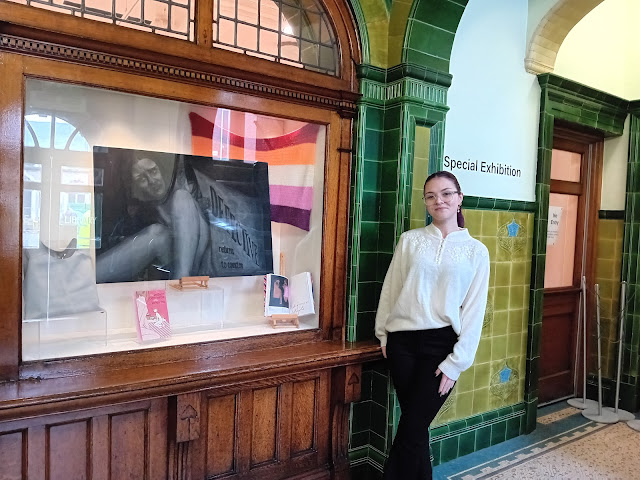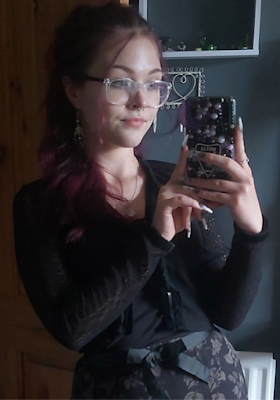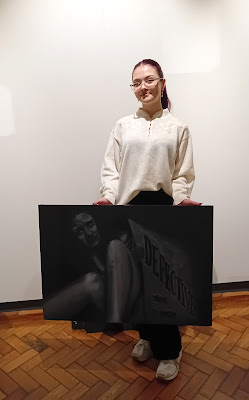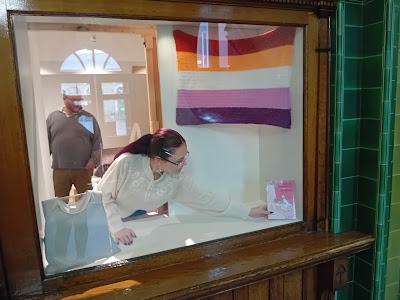13 November 2023 - 19 October 2024
Pontefract Museum
Free - no booking required
"With this exhibition, I hope that we can bring more awareness and start more conversations about identity – all of us have an identity, so why shouldn’t we talk about it?"
 |
| 'Boxed In (From Whence You Came)' by Fern Woodhead, now on display at Pontefract Museum |
Introduction
A brand-new artwork by Pontefract’s own Fern Woodhead (they / them), aged 18,
is now on display at Pontefract Museum!
Boxed In (From Whence
You Came) explores Fern’s feelings about “being a queer person in an
inherently non-queer society.” The striking oil pastel self-portrait is a
response to Fern’s identity as a non-binary person and a lesbian.
The display also features supporting commentary written by Fern along with personal items they have kindly lent for the exhibition. These include the Grayson’s Art Club exhibition catalogue in which they feature, and a hand-made crocheted lesbian pride flag.
Fern hopes that the exhibition will raise awareness and start conversations around sexuality and gender identity. Wakefield Museums & Castles are very proud to acquire and display such an important and inspiring artwork and to showcase exciting local talent like Fern. The acquisition contributes to ongoing work to diversify the collection so that it represents a wide range of people’s lived experiences.
 |
| Fern with their finished exhibition at Pontefract Museum |
Fern Woodhead on 'Boxed In (From Whence You Came)'
 |
| Fern Woodhead |
‘Boxed In (From Whence You Came)’ explores my feelings about being a queer person in an inherently non-queer society. Obviously we’ve made leaps and bounds in terms of queer acceptance both legally and socially, but it’s still incredibly easy to feel, or to be made to feel, like an outsider or like you’re being judged for something that should be seen as completely normal.
Politically, there are also many who have or currently are expressing incredibly anti-queer opinions which make our community feel isolated and unstable, unsure of where we stand in a supposedly tolerant society.
I am both a lesbian and a nonbinary person, and this piece explores both of those aspects of my identity. The title and subject of the piece comes from feelings of being ‘made wrong’, which I and many other queer people have experienced.
I spent the majority of my teenage years wishing I could be ‘normal’ and wondering why I had to be different to all my peers. I spent a very long time from the age of twelve questioning my identity and who I was. I knew I was a lesbian from roughly the age of thirteen, but I didn’t ‘officially’ come out until I was around fourteen because I was afraid to admit to myself that I was a lesbian – I think there’s a lot of shame and stigma around the word, and a lot of people associate it with something gross or sexual.
It can be incredibly isolating to admit that you’re completely uninterested in men when society is so androcentric and it’s easy to feel like you’re alone, especially if you don’t have any lesbian friends who you can talk to about your experiences.
Even now that I’m older, it sometimes feels strange or even wrong to publicly show affection to girlfriends, and you sometimes get a few funny looks, which I think comes as a shock to a lot of people who don’t realise that we still have a long way to come in terms of acceptance and tolerance.
I’m very open about being a lesbian now, and I hope that thirteen-year-old me would be proud of how completely unashamed I am of my sexuality. By the time I hit fifteen, I’d accepted my sexuality, but I was now questioning my gender instead (it felt a bit like I’d stepped out of the frying pan and straight into the fire).
I had a few trans and nonbinary friends at the time, so this wasn’t completely new to me, but it was scary realising that I didn’t really feel ‘normal’. There were a lot of feelings and experiences that I’d been repressing, but once I added them up it started to make a bit more sense to me.
I wouldn’t say I’m embarrassed to tell people that I’m nonbinary, but sometimes it’s easier to not tell people because they don’t understand (and don’t want to understand either) or they try to convince me that I’m wrong because ‘there are only two genders’.
I think there’s a lot of misunderstanding when it comes to gender identity, and this certainly isn’t made any better by people in the public eye, especially politicians, spreading misinformation, which only fuels people’s lack of understanding. There also seems to be a lack of teaching about gender identity, or when it is taught about there is a lot of incorrect information, such as ‘nonbinary’ being a third gender, when in fact most would view it as more of an umbrella term for lots of different gender identities.
There also seems to be a common idea that nonbinary people must be androgynous so that you ‘can’t tell if they’re a man or a woman’, but in reality, everyone expresses their gender in different ways and it’s not a one-size-fits-all. I could be incredibly feminine or incredibly masculine, and my gender identity would remain the exact same.
I used to present myself in a more masculine way, and I would use a chest binder to give the appearance of a more masculine body, whereas right now I am happy being feminine, and in both cases my gender identity did not change, just the way I presented myself.
It’s incredibly frustrating to hear misinformation being spread, as it only contributes to general feelings of transphobia, whether it’s intentional or not, and I hope this is something that will improve in the future.
With this exhibition, I hope that we can bring more awareness and start more conversations about identity – all of us have an identity, so why shouldn’t we talk about it?
Normalising conversations about sexual and gender identity helps queer people express their identities without feeling shamed, judged, or unsafe.
With this art piece I hope that I can contribute to starting these conversations and help people reflect on their own identities more.






No comments:
Post a Comment
We would love your comments - though they may take a day or two to appear.